Snakes have always fascinated human beings for all sorts of reasons, including their lack of limbs, their cold-bloodedness, and the fact that some of them wield venom powerful enough to kill a grown man. A few snakes grow to an intimidating size, and the bigger and longer the snake is, the more they enthrall people. These big, dangerous snakes are the most likely to be collected for zoos. In the meantime, there are hundreds of species of snakes whose members live their lives humbly, barely noticed, some not much longer than earthworms. In recognition of these reptiles, here is a list of the world’s smallest snakes, from descending size.

#10. Short-Headed Garter Snake

Garter snake is a common name for generally harmless, small to medium-sized snakes.
©Eric Dale/Shutterstock.com
This snake is one of the thousands of garter snakes, which are members of the Thamnophis genus. Garter snakes are found only in North to Central America, and the short-headed is one of the smaller garter snakes at around 10 inches in length.
This particular snake is only found in New York and Pennsylvania. It is almost always found near a field and is sometimes kept as a pet. They eat only earthworms in the wild, but as pets, they’ll take small amphibians, fish, and even leeches.
Though short-headed garter snakes are hesitant to bite if they’re picked up, they will excrete feces or a bad-smelling musk if they’re annoyed.
The reproductive strategy of the snake depends on where it lives. Females reproduce every other year in New York, but those in Pennsylvania breed every year. Like other garter snakes, the short-headed gives birth to live young.
#9. Malagasy Blind Snake
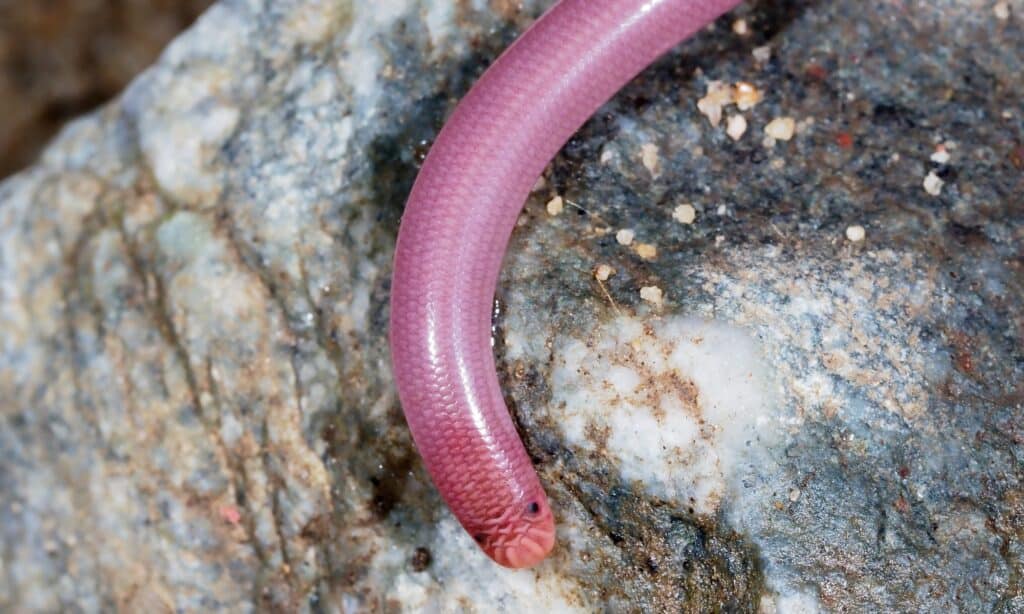
Blind snakes look similar to earthworms with their translucent scales.
©iStock.com/MikeLane45
Rediscovered in 2007 after about a hundred years, this snake is only found in Madagascar and grows to around 9.8 inches long. Its nose is so armored and enlarged that it makes the snake’s head look somewhat like a bulldozer.
The Malagasy blind snake has scales that are not only pink but translucent, much like an earthworm. It does not have a lung but has a membrane where the lung would be. Like other blind snakes, this one burrows into sandy soil found in the coastal forests, using its hard head to dig. It’s considered critically endangered.
The snake eats ants and termites, which it hunts by following their smell and the heat given off by their bodies.
#8. Ringneck Snake
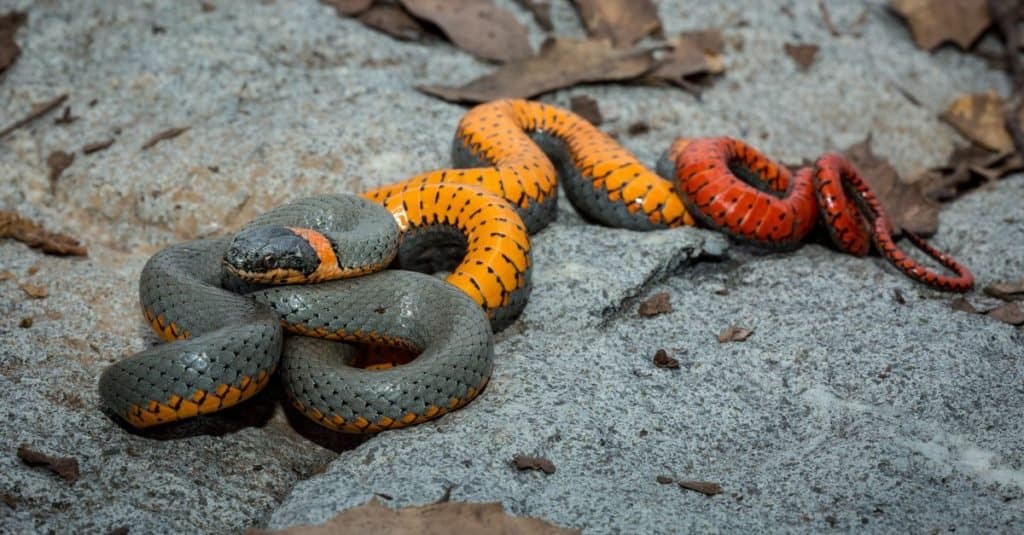
Ringneck Snakes will play dead when threatened.
©Michael K. McDermott/Shutterstock.com
Found from Canada down to central Mexico, this nocturnal snake gets its name for the band of yellow, red, or orange-yellow around its neck. Otherwise, the rest of the snake can be olive green, blue-gray, brown, or charcoal. Some herpetologists believe there are about 14 subspecies of this snake. All are about the same size, about 9.8 inches long. The exception is the regal ring-necked snake, which is a bit longer.
Unlike the other snakes discussed here, the ringneck snake is venomous, but it is just venomous enough to subdue its prey. This includes other reptiles such as lizards or young snakes of other species, amphibians such as frogs and salamanders, and slugs and earthworms. People can handle the ringneck snake because it’s peaceable and its fangs are tiny and rear-facing. When it feels threatened, the snake curls up its tail and exposes its anal vent, which is bright red.
#7. Lined Snake
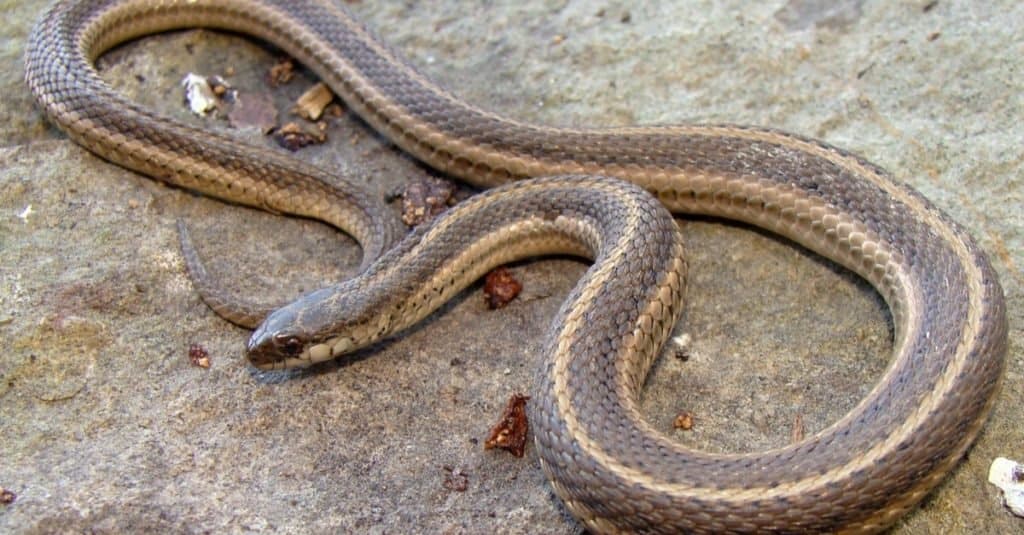
Lined snakes are small and thin and have small heads that are hardly wider than their body.
©Matt Jeppson/Shutterstock.com
This snake, which can grow from 8.66 to 15 inches long, is found in the Great Plains and has populations as far east as Illinois. There are four subspecies. They are the central lined snake, the northern lined snake, Merten’s lined snake, and the Texas lined snake.
Lined snakes are found in the woods, prairies, around human habitation, and abandoned lots. They hibernate during the winter in rocky crevices. Females are ready to breed when they’re about two years old, and though lined snakes mate in the fall, fertilization of the female’s eggs is delayed till spring. The female gives birth to two to 12 live young in August. Since they are born independent, they receive no parental care.
The lined snake mostly eats earthworms and can be found looking for them after a rain. It also eats snails and slugs.
#6. Peters’ Thread Snake
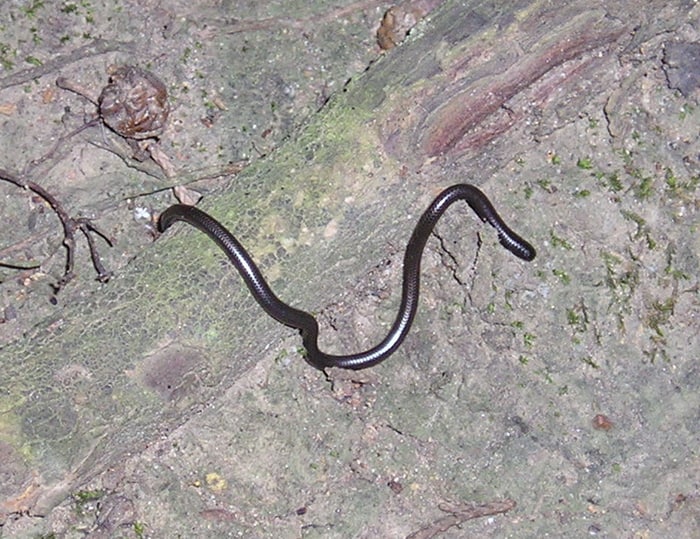
The Peters’ Thread Snake resembles a worm, and can be hard to distinguish the head from the tail.
This snake is found in southern Africa and grows to only about 7.9 to 11 inches in length. Like other thread snakes or blind snakes, an observer has to look hard to tell the tail from the head if the snake isn’t moving. This is because the snake’s eyes are minuscule.
This thread snake spends much of its life in a burrow, though it will emerge after a heavy rainstorm. Since it eats termites and termite eggs, it can often be found around old termite nests. It’s also easy to find under rocks and logs. Its scales are dark and shiny, and though it’s not venomous, some people confuse it with the burrowing asp, which is also a small snake but highly venomous.
#5. Flat-Headed Snake
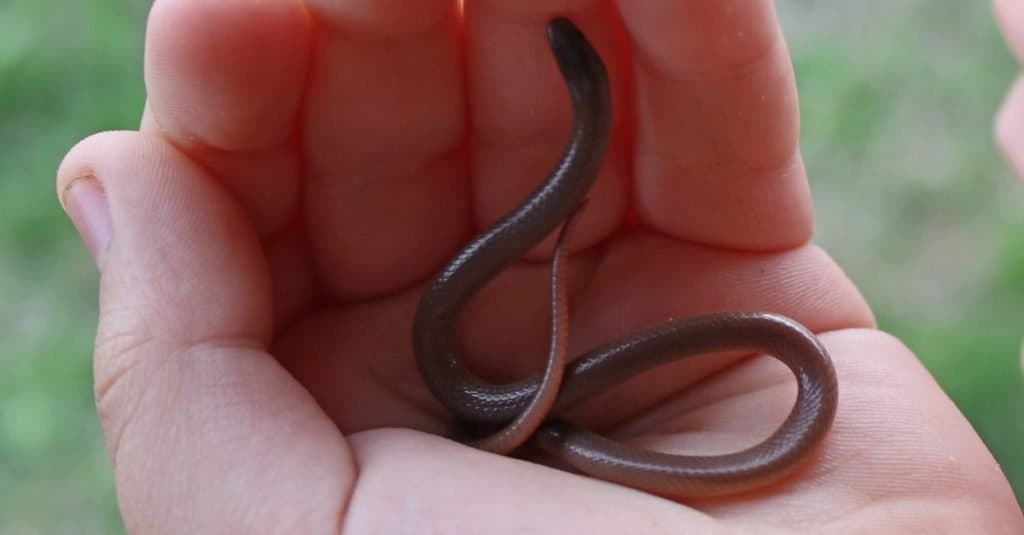
The Flat-Headed Snake is a burrowing species. It spends most of its time in slightly moist soil under rocks or in underground burrows.
©Creeping Things/Shutterstock.com
This 7 to 8-inch long snake is the smallest of the many snakes found in Missouri. It’s not endemic to Missouri but can also be found in Illinois, Oklahoma, Kansas, Arkansas, and Mexico. It has smooth scales whose colors range from tan to grayish or reddish-brown with a pink belly.
Sometimes the snake’s head is black. It is active through the warmer months but spends much of the day in burrows dug out of sandy soil. The snake breeds in spring, and the female lays one to four eggs in June. The 3 inch long babies hatch in late summer. The snake eats insects, insect larvae, and centipedes.
Check out the largest flathead snake ever recorded.
#4. Texas Blind Snake
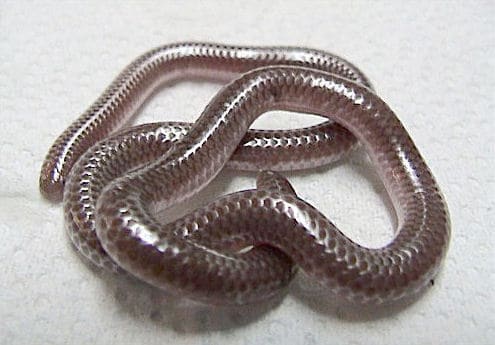
The Texas blind snake is able to discern different intensities of light.
The Texas blind snake is found from southwestern Kansas and south into Mexico. As with other blind snakes, it is easy to mistake this reptile, which grows between 3.94 and 11 inches in length, for an earthworm. It is found in deserts and other dry places as long as it can find protection from the hot sun and a source of moisture.
It does this by sheltering under logs or rocks and can even be found in the compost piles of suburban yards. Of the four subspecies of this snake, two are found in Mexico and two are found in the United States. The conservation status for these snakes are least concern.
The Texas blind snake is a burrowing snake and often follows the trails of earthworms, though it doesn’t eat earthworms, but ants, termites, and insect eggs. It has no teeth in its upper jaw and only has teeth at the front of its lower jaw. After mating, females lay about four long, narrow eggs with papery shells. These snakes aren’t completely blind and can discern different intensities of light.
#3. Variegated Snail Eater
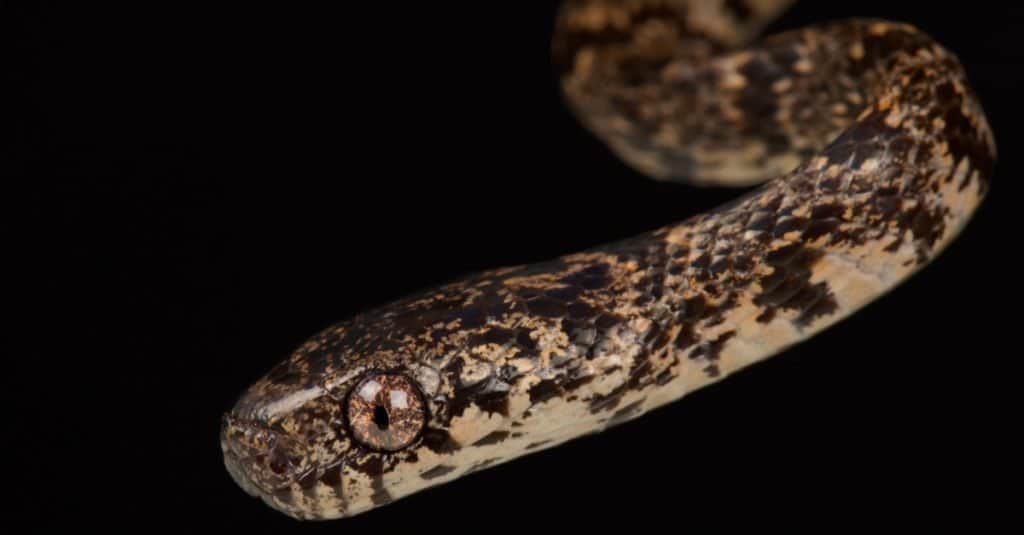
Variegated Snail-Eaters are harmless to humans. They are extremely docile and never attempt to bite.
©reptiles4all/Shutterstock.com
This snake is found in Amazonia and grows to just 3.4 to 3.59 inches in length. Slugs and snails make up a good part of its diet. It has a blunt, large head, large yellow eyes, and a pattern of blacks and grays over the body.
It’s found in old-growth forests or forests that have only been slightly disturbed. It is active at night, where it can climb up to 9 feet in search of prey. By day, the variegated snail eater sleeps under the duff or in shrub branches. Besides Amazonia, other populations of the variegated snail eater are found in Trinidad and Tobago.
The technique it uses to eat slugs and snails comes from its teeth, which are long and delicate. Firstly, the teeth at the front of its upper jaw secure the body of the snail. Then the lower jaw moves forward and the lower teeth are used to extract the the snail from its shell as the snake’s jaw retracts.
#2. Brahminy Blind Snake

Brahminy Blind Snake may get into homes along with potted plants, or come in from outside by crawling under doors or through cracks.
©Patrick K. Campbell/Shutterstock.com
The length of this snake can be as little as 2 inches, but since it can grow to 6 inches it’s probably only the second smallest snake in the world behind the Barbados thread snake. It is native to Asia and Africa but has been introduced to other areas of the world by stowing aboard potted plants, which gives it the nickname of “flowerpot snake.” It is difficult to tell the head from the tail as they have the same type of scales, but if a person uses a magnifying glass, they’ll be able to discern two tiny, useless eyes at the head and a bit of a spur on the tail. The snake comes in a range of colors from dark gray, silvery, yellowish beige, purple, and albino.
This snake dines on ants and termites as well as their eggs, larvae, and pupae. It will also take beetles, the eggs and larvae of other insects, caterpillars, and earthworms. Unlike other snakes, it may even eat feces and fungi. One truly weird thing about the Brahminy blind snake is that all of them are female. The species is parthenogenic, which means females can have babies without male participation. When the one to eight eggs laid by a Brahminy blind snake hatch, all are female, and all are identical to their mother.
#1 Barbados Threadsnake

The Barbados Threadsnake can curl up on a U.S. quarter.
This recently discovered snake is considered the smallest snake in the world, with an adult length of about 3.94 inches and no more, as far as anyone knows, than 4.09 inches. As its name implies, it was found in Barbados and might also be found in Barbuda and Antigua. It was found living under a rock and eats termites and the larvae of ants.
The Barbados Threadsnake was first identified as a separate species in 2008 by a herpetologist named S. Blair Hedges. Hedges named this snake after his wife. Although specimens had previously been collected prior to 2008, it was believed to have belonged to a different species. The snake generally thought to be the absolutely smallest a snake can get on Earth.
An interesting fact about this tiny snake is that the female lays only one egg at a time, and when the baby hatches it’s already half the size of the mother. Herpetologists believe this thread snake evolved to live in forests, so due to the massive deforestation of Barbados, its conservation status is “critically endangered.”
What Other Reptiles or Amphibians Are Especially Tiny?
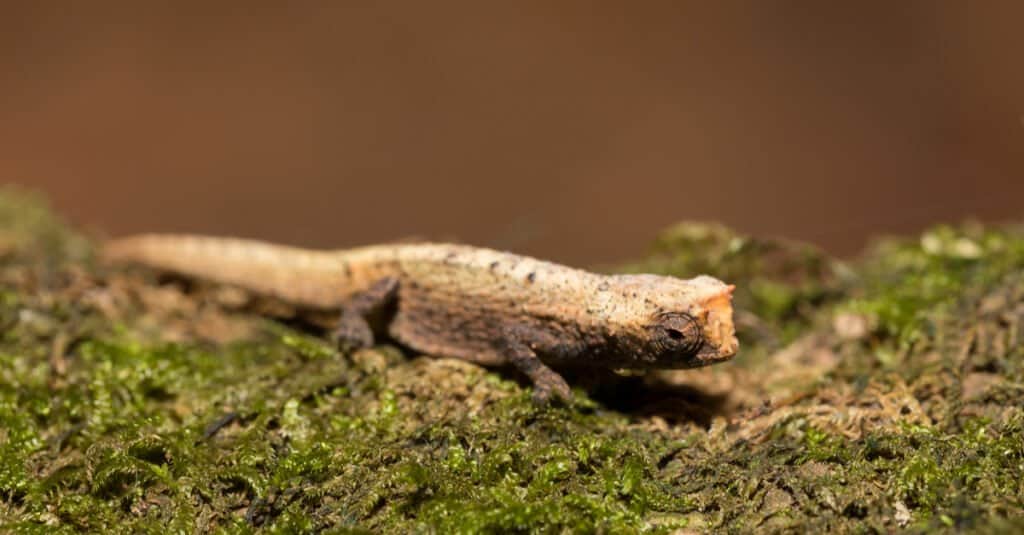
The Brookesia nana is the world’s smallest reptile and is capable of growing to 1.1 inches.
©Artush/Shutterstock.com
The speckled tortoise: There’s only one place to find this small reptile on the globe: southern Africa, in Namaqualand, to be precise. There among the rocks which cover the landscape, the reptile also known as Chersobius signatus, can be seen munching on succulents which are its favorite food.
Males are capable of growing slightly over 3 inches while females are capable of reaching 4 inches in size. Both genders are capable of reaching a maximum weight of 8 ounces.
The Brookesia nana: The title of the world’s smallest reptile goes to this miniature lizard which is slightly longer than the head of a matchstick. Native to Madagascar, males grow to 0.9 inches, while females are capable of making it over the 1-inch mark.
Unlike other members of its color-swapping family, the reptile, also referred to as the nano-chameleon is incapable of changing its dark brown coloration.
The Brazilian gold frog: Also known as Brachycephalus didactylus, this tiny frog is found in the Brazilian states of Espírito Santo and Rio de Janeiro. The amphibian which is known for its golden bronze coloration is capable of growing to 0.4 inches.
Summary of the Top 10 Smallest Snakes in the World
Let’s take a look back at the tiniest of snakes that inhabit our planet:
| Rank | Snake |
|---|---|
| 1 | Barbados Threadsnake |
| 2 | Brahminy Blind Snake |
| 3 | Variegated Snail Eater |
| 4 | Texas Blind Snake |
| 5 | Flat-Headed Snake |
| 6 | Peters’ Thread Snake |
| 7 | Lined Snake |
| 8 | Ringneck Snake |
| 9 | Malagasy Blind Snake |
| 10 | Short-Headed Garter Snake |
Up Next…
- 9 Smallest Reptiles in the World Meet the smallest reptiles on Earth in this interesting article.
- Meet the Biggest Horses in the World From Clydesdales to Shires, here’s a look at the horses that tip the scale as the biggest.
- Amazing! 12 Types of Hybrid Animals That Actually Exist Did you know that there are a variety of fascinating hybrid animals that will make your jaw drop? Read on to discover them.
The photo featured at the top of this post is © Egoreichenkov Evgenii/Shutterstock.com
Discover the "Monster" Snake 5X Bigger than an Anaconda
Every day A-Z Animals sends out some of the most incredible facts in the world from our free newsletter. Want to discover the 10 most beautiful snakes in the world, a "snake island" where you're never more than 3 feet from danger, or a "monster" snake 5X larger than an anaconda? Then sign up right now and you'll start receiving our daily newsletter absolutely free.
Thank you for reading! Have some feedback for us? Contact the AZ Animals editorial team.







